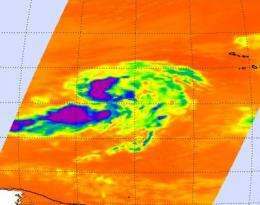Infrared NASA image shows strong convection in new Atlantic Depression 9

The Atlantic Ocean is in overdrive this week, and NASA satellite imagery captured the birth of the ninth tropical depression in the central Atlantic Ocean today, trailing to the east of Tropical Storm Fiona.
NASA's Atmospheric Infrared Sounder (AIRS) instrument, flying onboard the Aqua satellite, captured an infrared image of Tropical Depression 9 on Sept. 1 at 03:41 UTC (Aug. 31 at 11:41 p.m. EDT). It showed high thunderstorm cloud tops west and southwest of the center of circulation indicating strong convection.
At 1500 UTC (10 a.m. EDT) on Sept. 1, Tropical Depression 9 (TD9) was born in the Atlantic Ocean. It had maximum sustained winds near 35 mph, and was moving west at 15 mph. It was located about 830 miles west-southwest of the Cape Verde Islands, near 12.4 North and 35.8 West. Although there are warm sea surface temperatures (as seen in NASA's infrared AIRS imagery) over the 80 degree Fahrenheit threshold that's needed to power up tropical cyclones, there is wind shear in the area, so intensification will be slow to occur.
When the storm becomes a tropical storm it would be named "Gaston."
Provided by NASA's Goddard Space Flight Center





















